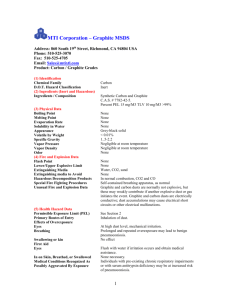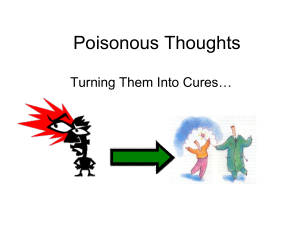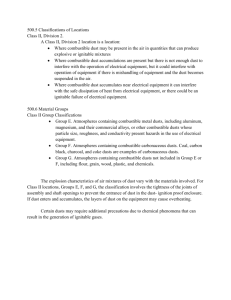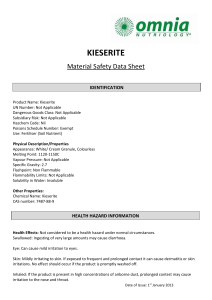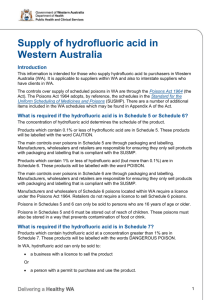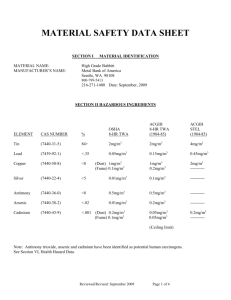Alice Hamilton presentation "Industrial Hygiene" at APHA in 1932
advertisement
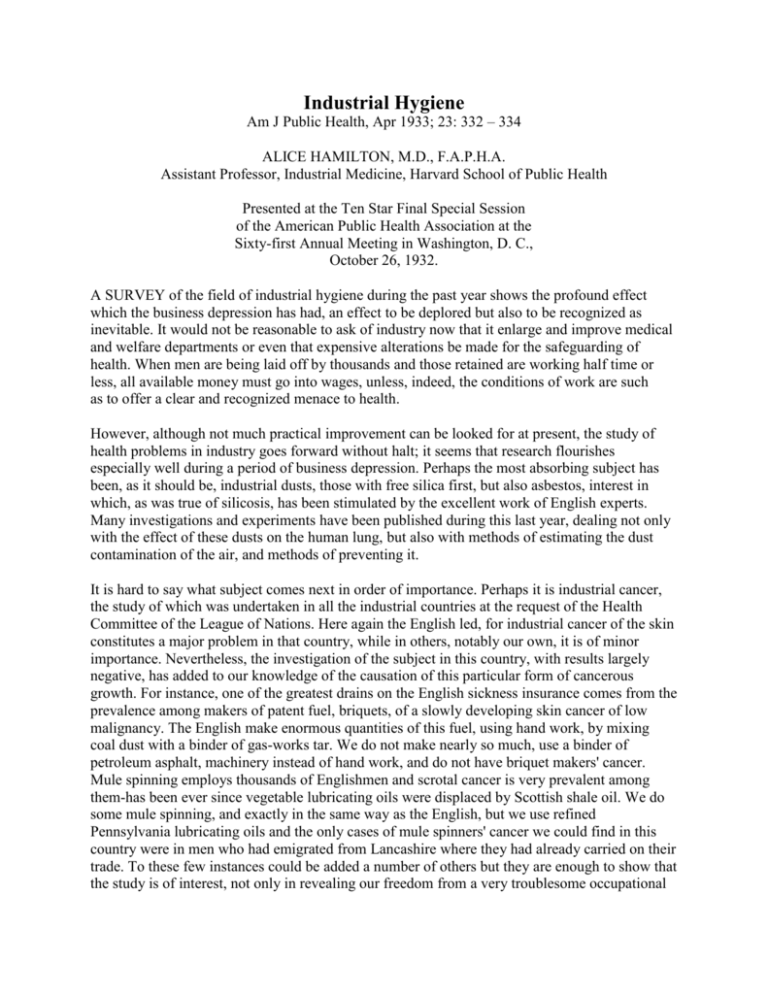
Industrial Hygiene Am J Public Health, Apr 1933; 23: 332 – 334 ALICE HAMILTON, M.D., F.A.P.H.A. Assistant Professor, Industrial Medicine, Harvard School of Public Health Presented at the Ten Star Final Special Session of the American Public Health Association at the Sixty-first Annual Meeting in Washington, D. C., October 26, 1932. A SURVEY of the field of industrial hygiene during the past year shows the profound effect which the business depression has had, an effect to be deplored but also to be recognized as inevitable. It would not be reasonable to ask of industry now that it enlarge and improve medical and welfare departments or even that expensive alterations be made for the safeguarding of health. When men are being laid off by thousands and those retained are working half time or less, all available money must go into wages, unless, indeed, the conditions of work are such as to offer a clear and recognized menace to health. However, although not much practical improvement can be looked for at present, the study of health problems in industry goes forward without halt; it seems that research flourishes especially well during a period of business depression. Perhaps the most absorbing subject has been, as it should be, industrial dusts, those with free silica first, but also asbestos, interest in which, as was true of silicosis, has been stimulated by the excellent work of English experts. Many investigations and experiments have been published during this last year, dealing not only with the effect of these dusts on the human lung, but also with methods of estimating the dust contamination of the air, and methods of preventing it. It is hard to say what subject comes next in order of importance. Perhaps it is industrial cancer, the study of which was undertaken in all the industrial countries at the request of the Health Committee of the League of Nations. Here again the English led, for industrial cancer of the skin constitutes a major problem in that country, while in others, notably our own, it is of minor importance. Nevertheless, the investigation of the subject in this country, with results largely negative, has added to our knowledge of the causation of this particular form of cancerous growth. For instance, one of the greatest drains on the English sickness insurance comes from the prevalence among makers of patent fuel, briquets, of a slowly developing skin cancer of low malignancy. The English make enormous quantities of this fuel, using hand work, by mixing coal dust with a binder of gas-works tar. We do not make nearly so much, use a binder of petroleum asphalt, machinery instead of hand work, and do not have briquet makers' cancer. Mule spinning employs thousands of Englishmen and scrotal cancer is very prevalent among them-has been ever since vegetable lubricating oils were displaced by Scottish shale oil. We do some mule spinning, and exactly in the same way as the English, but we use refined Pennsylvania lubricating oils and the only cases of mule spinners' cancer we could find in this country were in men who had emigrated from Lancashire where they had already carried on their trade. To these few instances could be added a number of others but they are enough to show that the study is of interest, not only in revealing our freedom from a very troublesome occupational disease, but also in adding to the gradually accumulating fund of knowledge concerning the chemical nature of the carcinogenic factor in oils, pitches and tars. This factor has not yet been isolated, but the pursuit is being narrowed down, and the end of the chase cannot be far off. Closely connected with this field is that of malignant growths caused by the action of radioactive substances. For many years it was a matter of common knowledge that the miners in the Schneeberg region of Saxony suffered to an amazing extent from pulmonary carcinoma. The cause was variously held to be the arsenic in the ore, the chronic irritation caused by pneumoconiosis, and the radio-activity of the dust in the mines. It was most puzzling, however, that on the other side of the mountains, in Bohemia, no such disease had ever been discovered. This last year, the mystery has been cleared up. An impartial and scientific inquiry into the Bohemian mines and the condition of the miners revealed the same prevalence of lung cancer as on the Saxon side, and, since in Bohemia there is little pneumoconiosis, the cause seems to be established as residing in the proven radio-activity of the ore dust. In this country our contribution to the study of new growths caused by radiation has been very important. I need only refer to the work of Martland, who first described the cases of aplastic anemia with bone necrosis in women who had been exposed to the action of alpha rays from the swallowing of luminous paint, and more recently has been publishing reports of the development of bone sarcoma in those who, less severely poisoned, have lived on and now exhibit this other type of effect. Judging by the attention it attracts, one would have to put chromic acid high up in the list of dangerous poisons, and yet we all know that its importance is insignificant; but the great growth of chrome plating has brought it about that many men are now exposed to chromic acid spray and this is one of the poisons that works conspicuously, producing injury that is not serious but is very easily recognized. The result is that enterprising members of the legal profession are able to make much undeserved trouble for manufacturers and to spread among workmen the idea that here is a very dangerous poison whose evident effects only mask the more deadly internal injuries. British factory inspectors report that no case of chrome ulcer undergoing carcinomatous degeneration has ever been reported, nor any case of constitutional trouble. The lesions are local always. Among the old familiar poisons we have a few new developments. More cases of arsenical poisoning due to the use of insecticides are being reported as such use increases. In lead, we have much evidence confirming Aub's theory of the storage of insoluble lead phosphate in the skeleton and its mobilization under conditions leading to a change in the hydrogen ion concentration, also confirmation of his therapeutic procedure based on this theory. Aub's latest pronouncement on the treatment of plumbism is as follows: De-lead by the administration of acids and a diet poor in calcium, keeping it up for 3 to 4 weeks, then interrupt when the patient has lost appetite and feels poorly. Resume it, if necessary, then follow with a calcium-rich diet, to restore the calcium which has been lost in the course of de-leading, inasmuch as calcium and lead metabolism go together. Coal tar benzene continues to be the subject of investigation, for in spite of all efforts at its elimination, it is still used to a considerable extent in industry. McCord has just issued a book dealing with benzene in all its aspects. Hydrofluoric acid and the fluorides are coming into much greater prominence because of their newer industrial uses and of their use as preservatives of foods. Pickling of metals is now done with hydrofluoric acid; sodium acid fluoride and sodium silico-fluoride are added to laundry soap mixtures; and although ordinary ground glass is now made by sandblasting instead of etching with acid, all electric light bulbs are frosted by immersion in this acid. The French have of late described what they call " fluorisme," chronic poisoning with hydrogen fluoride, which they have observed in man and produced in animals, by prolonged ingestion of minute amounts or exposure to the fumes. It consists in cachexia, rigidity of the spine, and fragility of the bones. Looking at the field of industrial hygiene in general, two things impress one: The first is that, because of widespread poverty and unemployment, we must expect a much larger number of unwarranted or exaggerated claims for alleged injury to be brought against employers by workers. This is understandable, but unless it is vigorously opposed, it will lead only to the disadvantage of the working class, by discrediting laws passed for their protection. The second is that, owing to this same cause, we must expect to see the loss of standards which is already only too evident, keep on for some time. Already we are forced to admit that it is better for a man or a woman to take employment at a wretchedly inadequate wage, or under conditions far from ideally healthful, than to join the ranks of the applicants for public charity. That unscrupulous employers will take advantage of this peculiarly helpless state of labor is to be expected, but even the scrupulous employer may well think that he would himself prefer to risk sickness rather than to face certain penury. Apparently we can do little now to stem the downward course, but surely we can be alert to sense the first signs of revival and then to begin at once to insist on a return to the higher standards of our prosperity, none too high, at any time.

